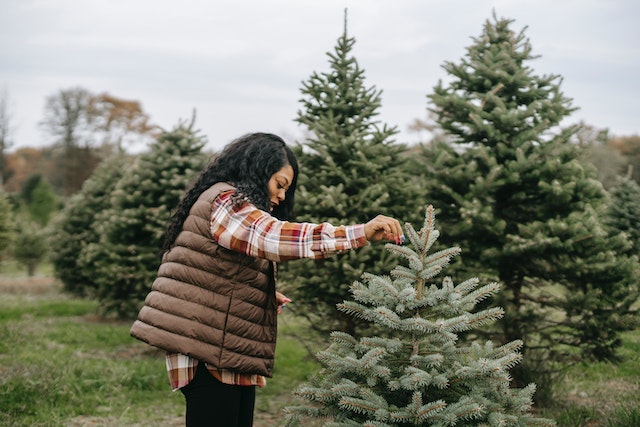The centerpiece is always the perfect Christmas tree for a beautiful, festive holiday space. Consider factors like tree type, size, needle retention, and more to choose the right one.

In this Ultimate Christmas Tree Buying Guide, we will walk you through everything you need to know to adorn your home with the best tree this season.
Tips to Remember When Buying a Christmas Tree
- Do not get overwhelmed by the fact that whatever Christmas tree you see is beautiful; just feel it in your heart, and you’ll find what’s perfect for your home.
- Always consider your home’s space, budget, and the people you’re with at home.
- When choosing the tree, use a precise ornament count calculation. This is essential if you don’t want your tree to look overly decorated or become a plain-looking Christmas tree.
- Feel the holiday season, whether you want to impose a festive holiday decoration or just an ordinary one. What’s important is that everyone feels the spirit of Christmas.
Choosing the Perfect Christmas Tree: Real or Artificial?
When deciding on a Christmas tree, the first significant decision is whether to choose a real or artificial tree; both have their merits and drawbacks.
Let’s look at each option to help you make the right decision for your holiday decor.
Real Christmas Trees
Pros:
- Natural look, feel, and scent
- Environmentally friendly
- No storage issues after the holiday season
Cons:
- Require regular care, such as watering
- It may trigger allergies in some people
- You need to purchase a new one each year
Artificial Christmas Trees
Pros:
- Reusable for multiple years, cost-effective
- Low maintenance, no watering needed
- Hypoallergenic and pest-free
Cons:
- Synthetic materials are less environmentally friendly.
- Require space for storage offseason
- Lacks authentic look, feel, and scent
Selecting the Ideal Tree Type
Choosing the right tree type is essential for a real Christmas tree. Each tree species has unique features, including needle retention, aroma, and shape. Here are some popular Christmas tree species:
- Fraser Fir: Known for its strong branches, excellent needle retention, and pleasing scent. Its soft and silvery needles make it an ideal option for sensitive skin.
- Balsam Fir: This classic choice offers a lovely fragrance, soft needles, and a pyramidical shape. Balsam Firs are generally less expensive than Fraser Firs.
- Douglas Fir: Popular on the West Coast, the Douglas Fir features a dense appearance, soft needles, and a sweet fragrance.
- Scotch Pine: With its thick foliage, sturdy branches, and excellent needle retention, it is an all-around popular selection with a traditional appearance.
- Blue Spruce: Ideal for those who prefer a unique tree with a hint of blue, the Blue Spruce boasts moderate to strong branches and good needle retention.
Finding the Right Size and Shape
Taking into account your living space and personal preferences, consider the following before settling on a Christmas tree:
- Height: Measure the ceiling height in your room and pick a tree at least 6-12 inches shorter; this leaves room for a tree topper and ensures the tree won’t brush against the ceiling.
- Width: Consider your room space and the area you want the tree to occupy. Trees are available in slim, complete, and extra-wide shapes.
- Branch Density: Some prefer full, dense trees to showcase more ornaments and lush appearance, whereas others opt for a more open and minimal branching structure.
Preparing the Space and Tree Stand
Before bringing your Christmas tree home, make some arrangements to ensure a smooth setup:
- Clear the Space: Make enough room for the tree, ensuring it’s not blocking walkways or causing a hazard.
- Secure the Tree Stand: Choose a sturdy and heavy-duty tree stand capable of holding the tree’s height and weight. It should also have a water reservoir for real trees.
- Protect Your Floors: Position a tree skirt or waterproof mat under the stand to catch any fallen needles or spills.
Tips for Choosing and Preserving Real Trees
For those opting for a real tree, follow these pointers to help you find and maintain the freshest, healthiest tree this holiday season:
- Inspect the Tree: Ensure needles are supple, branches are pristine, and there’s minimal needle loss when you shake the tree.
- Fresh Cut: Ask the seller to make a new cut at the tree’s base or yourself before placing it in the tree stand. This will optimize water absorption for the tree.
- Keep it Hydrated: Check the water level daily, ensuring the tree base is always submerged. Real trees can consume plenty of water to maintain their freshness.
- Tree Disposal: Use a recycling program or yard waste collection to dispose of your tree responsibly after the holiday.
Artificial Tree Assembly Tips
If you choose an artificial tree, follow these basic steps for a perfect, hassle-free setup:
- Unbox and Unfold: Carefully unbox the tree, unfold the branches, and follow the manufacturer’s instructions for assembly.
- Fluff the Branches: Gently fluff the branches to spread them out in a more natural appearance.
- Secure the Sections: Assemble the tree from the bottom up, ensuring each section is fitted securely according to the manufacturer’s assembly guide.
Decorating Your Tree
Once you’ve selected and set up your tree, it’s time for the fun part! Add lights, ornaments, and garland for a beautifully decorated tree:
- Use LED Lights: They are energy-efficient and produce less heat, making them a safer option for your tree.
- Layer the Decorations: Start with lights, then proceed to garland and ornaments. Place heavier and larger ornaments on sturdy branches closer to the center, while smaller, delicate ornaments can go on outer branches.
Final Thoughts
The perfect Christmas tree sets the stage for an unforgettable holiday season. By considering the various factors outlined in this Ultimate Christmas Tree Buying Guide, such as tree type, size, and species, you can make an informed decision and select the tree that suits your home, budget, and taste.